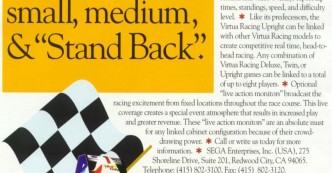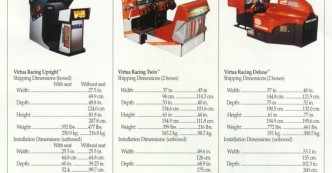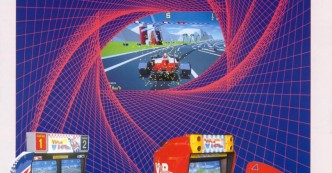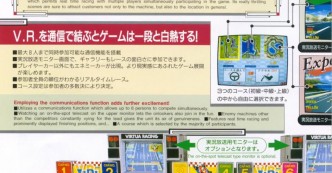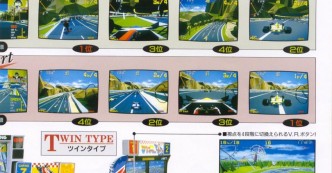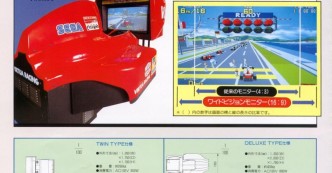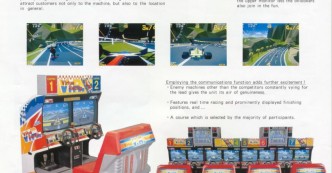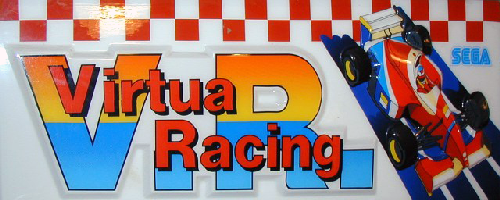
Chasing Ghosts: One Quarter at a Time
The future is 3D! A look at the beautiful polygon-filled Virtua Racing
3D!
Ask any game-playing person in the early 90s what technological advancement they wanted to see in video games, and chances are, they would answer, “3D graphics.”
Video game history is filled with attempts at bringing 3D gaming to consumers. There’s 1984’s I, Robot from Atari, a groundbreaking arcade shoot-em-up that gave us solid, colorful 3D polygons instead of wire-frame monochrome graphics sported by games like Speed Freak (1979) and Star Hawk (1979). And then you had “gems” like Hard Drivin’, which did a nice job with 3D graphics, but featured mundane driving, feeling more like something you’d play at a DMV than an arcade (although it did show you an instant replay of your crash which was fun).
3D gameplay was the dream. Nowadays, 2D sprite based games like Shovel Knight are all the rage, but back in the early 90s, we didn’t want no stinkin sprites. We wanted 3D! Give us 3D now!
And Sega answered my prayers, put studio Sega AM2 to work, and gave me Virtua Racing.
- US Flyer advertising different size machines, with the emphasis on the standup machine, which takes up much less space but could still pull in a lot of quarters.
- Chart showing the different dimensions of the Virtua Racing Machines. I’ve only seen the one player sit down cab on the right in person.
- Front of the Japanese Flyer. Nice subtle Bond reference there on the cover, though I’m sure it was accidental.
- Inside of the Japanese Flyer, also written in English, showing off all the stages and colors.
- Inside of the Japanese Flyer. Great usage of screen shots in this flyer, something that isn’t always done well.
- Japanese Flyer back
- Single page Euro flyer showing that you could connect four twin units for 8 player racing. Something I’ve never done on any arcade racer (most I’ve gotten was 3)
This was beautiful. The graphics in this game were fantastic. Getting into the cockpit, these 3D polygons gave you the sense that you were really behind the wheel. Because you were: the game allowed you to view the game from a first-person perspective, something that had been done before in Namco’s Winning Run (1988) but I didn’t have the luxury of trying.
And luxury is a fitting word, because to play a game of Virtua Racing would never cost just a quarter. You had to pay a dollar for the privelige of 3D racing. Which for me was a huge sacrifice because arcade racing games are the genre I am absolutely the worst at. Aside from Mario Kart, I’ve never once finished any higher than 6th place or so in an arcade racing game, usually running out of time and getting a game over screen.
Side note, could you imagine watching NASCAR or Indycar racing on TV, and seeing a driver come to a stop on the track because he didn’t pass the checkpoint in time?
Luxury also springs to mind when I think of the home release of Virtua Racing. $99.99 on the Sega Genesis with no extra content or features. The hefty price is due to the inclusion of the Sega Virtua Processor, which gave the cartridge a bulky but kind of cool look. Although they put Virtua Fighter on the 32X and Saturn, as a kid I desperately wished they would have brought that game to the Genesis using the SVP chip, as I would have begged my parents and saved my money for that (yes they have Virtua Fighter 2 on the Genesis, but that doesn’t count because that game sucks).
It was a fun rental, one of the most fun games I rented for the Genesis now that I think about it. It’s one of those Genesis titles that brings up so many good nostalgic memories of late night drives around the polygonal track. I didn’t purchase it for myself until 2007, when I got it for $7.99, complete with manual and box. Bargain!
But dear reader, I do sound like I’m giving Virtua Racing the short stick. It’s not the game’s fault I was horrible at racing games. Just a sad fact of life. Sure, looking back the game is quite limited. Three tracks, only one style of car (although the operator could turn it into different colors from the service menu, including pink), no upgrades, no cup or grand prix mode. Just exhibition (1-2 player) racing. Breathtaking graphics, fantastic sound (that menu music you’ll hear at the beginning of the Youtube video below is one of my favorite arcade and 16-bit tunes), but barebones gameplay.
And you know what? That’s ok. Sure, that might be a sticking point if you’re plopping down $100 for the home console version, but you didn’t play Virtua Racing for season modes or wild customization options. You played Virtua Racing because you loved racing games and because it was the absolute best looking arcade game that you had ever seen.
Playing it in MAME
Yes, you can technically play this in MAME. It runs really smooth (although it took slightly longer to load than any other games in my cabinet), no problems at all. But the controls are where you have issues. This game was made with a steering wheel in mind. Using a joystick, the steering can be too sensitive, putting you into a wall when you first start playing. Eventually you’ll get the hang of it, and even I, with my complete lack of talent in racing games, managed to finish eighth on the beginner track. You can easily map the acceleration and brakes to the pushbuttons. I’d recommend playing with an automatic transmission, as having to hold down gas while still pressing a button to change gears could become overwhelming.
I thought it would be a trip to map the gear shift functions to the second joystick, which is a great idea in theory, but awful in practice: it’s really hard to keep your hand on the second stick and find a way to brake and accelerate quickly, not to mention steering with your left hand. Perhaps this would work if you mapped the left and right steering directions to a button.
But playing a racing game with a gamepad or joystick just isn’t as much fun. You want the wheel. You need the wheel for games like this.
Fortunately, you can buy arcade quality steering wheels for a price (Suzo Happ has the Steering Wheel Assembly for $327). If racing games are your thing, I’d recommend building a MAME cabinet specifically designed for racing games (no joysticks, just pedals, gear shift and a wheel) instead of the standard cabinet. Keep in mind though, that arcade racing wheels are not universal: There are Optical (360 degree) wheels used on games like Pole Position and Roadblasters, and analog (270 degree) wheels made for games like Out Run and Spy Hunter. Plus different games have different gear shifts: Pole Position is high and low, while newer racing games have 4-5 gears. Yes you could play with automatic transmission instead of manual, but that isn’t nearly as much fun.
Or use a wheel made for PC gaming and run this off an emulator on your PC, but damnit, we strive for authenticity around here. Either a real cabinet, a MAME cab, or nothing at all!
Hmm, a MAME cabinet with driving controls. That sounds like a good project to start…
(Wife’s note: NO!)
My wife plays Virtua Racing
In an effort to get my wife to play more video games, I have given her space in this column to talk about her experiences with the featured arcade game. Follow her on Twitter @alliwait
It wasn’t too bad. The car was too loud though: I was distracted by the noise everything was making. The tires, the background, the whole thing.
I like racing games. I liked spinning out by accident.
I would have enjoyed it a lot more with a wheel but the stick wasn’t too bad. I wasn’t cursing the name of the game or anything. It ended up being a lot of fun.
Virtua Racing (1993)
Developed by Sega AM2, published by Sega.
Released in the arcades, the Sega Genesis, 32X (Virtua Racing Deluxe), Sega Saturn and Playstation 2.
Full technical information available here.
